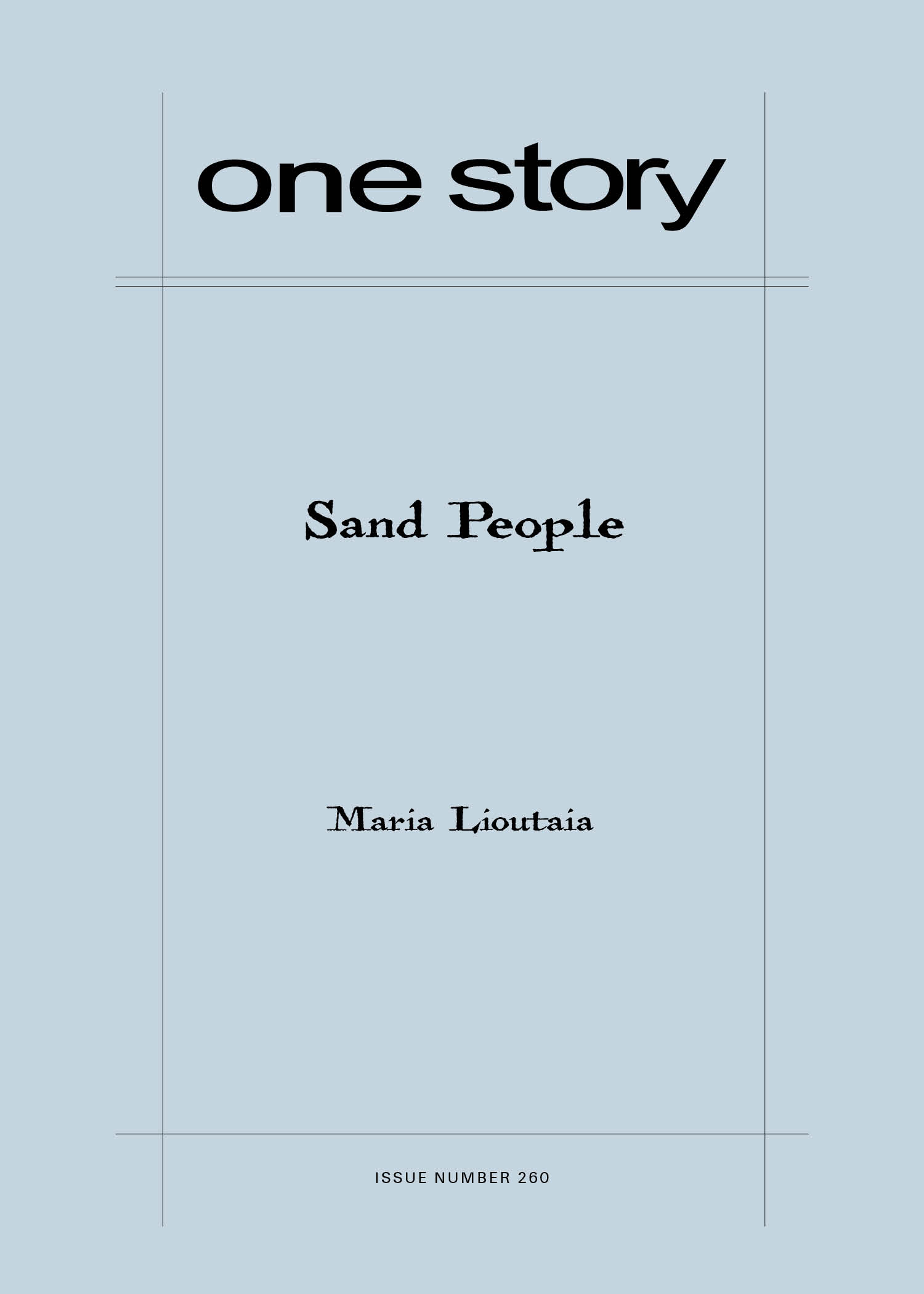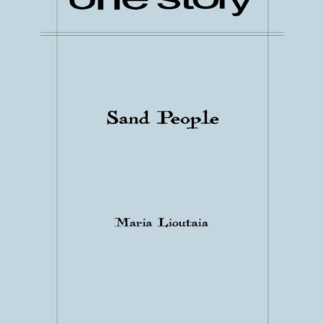
Sand People
$2.50
63 in stock
Excerpt
The kid is brought to us by a social worker. She ushers him onto the sagging porch tender with rot, and they look up at the house. The salt spray has peeled the paint back, curled its edges until it looks like patches of fungus along the clapboards. We are also looking, from the faceted window, looking at the boy standing there bewildered and wind-slapped with a green duffel at his feet.
He fingers the wind chime we made from shark teeth and fishing wire, runs his hand down the sea-snake spine nailed to a porch beam. He is skinny and pale and delicate-seeming. Reminds us of a lost sea bird, the kind that’s slammed against the peninsula by nor’easters blowing through. The kind we make into stew, beaks and all.
The social worker raps the screen door with her knuckles. We slide back the deadlock and step out onto the porch.
You are his closest living relatives, the letter had said. We hadn’t had any mail in years. We only dimly remembered his mother, met her once when she was a child not much younger than this boy. We remembered her because when she asked us why we looked like this, and we said we’d been enchanted, she nodded thoughtfully, believed us. Do you wish to rescind your guardianship and put him in the foster system? No, we’d decided, after thinking it over some. That seemed cruel, especially once we read what the boy had been through. Still, we’re apprehensive about this change.
Maria Lioutaia
Maria Lioutaia was born in Moscow. She now lives and writes in Toronto, where she is working on a novel. Her fiction has also appeared in Tin House, Electric Literature’s Recommended Reading, Conjunctions, and others. She holds an MFA from NYU, where she was a Goldwater Fellow. Her last name means “fierce” in Russian.
Hannah Tinti on “Sand People”
Living by the sea is one thing in spring and summer and something else entirely after winter sets in. The beaches are deserted, the sky turns gray, and the cold wind seeps deep inside your bones. But there is a magic to winter beaches—the open emptiness, the twisted driftwood and monstrous carcasses of boats and creatures that wash onto the shore. It casts a spell, just like the kind Maria Lioutaia does in her wildly creative short story, “Sand People.”
Set on an isolated peninsula for lost souls, “Sand People” begins with the depositing of an orphan boy into the home of his aunts, a set of conjoined twins. These witchy aunts make him skirts of seagull feathers and teach him how to weave nightmare-catchers but also warn him to stay away from the Sand People—the human-shaped holes that glide up and down their shoreline. These sand shadows are captivating and ultimately heartbreaking, just as the affections and jealousies that arise in this three-legged, broken family. “Sand People” is about aloneness and togetherness. About the sucking pulls of despair and the saving ties of connection.
I hope you’ll read our author Q&A, where we discuss the inspiration behind “Sand People,” and how to find balance with the strange and the surreal. It’s exciting to see the leaps of fierce imagination on the page, and it’s a thrill to wade into these winter waters with Maria Lioutaia. You never know what will be conjured next.
Q&A by Hannah Tinti
- HT: What was the seed of this story? What was the first thing you wrote?
- ML: Early one morning, I was walking along the beach at Sandbanks Provincial Park in Ontario. It was early enough that there weren’t any other people out yet. There were a few holes dug in the sand by the water, left by kids from the day before. And for some reason I decided to creep myself out by imagining that these holes were secretly following me along the beach, freezing in place whenever I got suspicious and turned around. I managed to slightly ruin the tranquility of that walk for myself, but the idea of holes moving along a wind-blasted beach was born.
- HT: What was the most challenging aspect of writing this story?
- ML: Most of my stories start off with at least some semblance of initial plot and direction. That may change drastically in later drafts, sure, but there’s still an idea of plot at conception. However, this is the first story I’ve ever written that began with only a brief image (see above: moving sand-holes), and I had to figure out the rest—characters, tensions, plot—as I went along. At first, it was just a short paragraph describing this slightly eerie beach setting. I sketched it out and then put it aside, thinking it was just a quick world-building exercise. Then a few months later I came across this paragraph, decided I could do more with it, and turned it into a very short (and not very good) flash piece—that’s when the “we” voice appeared, though I still wasn’t sure who this “we” was. It was only many, many drafts later that the story became what it is now. At every stage I felt like there was a lot of digging I still had to do, that the material had more potential than I was giving it, so it kept growing. There were many times I felt it was too strange and unwieldy and I was ready to give up and declare it a dead draft, but something always compelled me to keep coming back to it and working on it some more.
- HT: The setting of this magical peninsula is so evocative. Is it based on a real place or was it entirely constructed from your imagination?
- ML: No real place in particular, but probably an amalgamation of certain oceanside stretches of land, mostly along the Atlantic coast. I drove up the north coast of Newfoundland some years back, from Gros Morne National Park to Quirpon. The feeling of that desolate, fierce wilderness stayed with me, and likely leaked out onto the page when I was creating this peninsula.
- HT: “Sand People” explores the tension between togetherness and aloneness. Was this theme something that you entered intentionally, or did it rise organically as you wrote?
- ML: The theme rose organically, as did most elements of this story. As a child, I loved playing on my own. Trying to get me to go to daycare led to hysterics. I was alone often, by choice, but was never lonely. Humans are strange creatures. We crave both independence and connection, community and individuality. Much like being alone and being lonely are not equivalencies, being alone by choice versus by circumstance are very different things. It’s possible to be lonely while in a crowd, and to not feel lonely even if you’re doing a solo multi-day hike and it’s been days since you’ve seen another person. I didn’t try and answer any of these musings in the story directly, but these ideas helped me when I was trying to work my way through this story and figure out what motivated the sisters and the boy and the people who came to join the sand people.
- HT: What are you working on now?
- ML: I’m working on a novel, which is an odd and scary and thrilling thing to admit to. When I’m not trying to wrestle that toothy beast into submission, I’m always working on more short stories.
- HT: What is the best bit of advice about writing you have ever received?
- ML: “Trust the process.” I don’t remember where I picked this one up, but it’s scrawled on an aged orange post-it note on my desk lamp. I’m someone who struggles with first drafts. I find them utterly excruciating—I have this Platonic ideal of a story in my head, a perfect nugget of a story, but when I try to get it down on paper, it comes out all...wrong and flat. I often have to work through many drafts and wildly different iterations on the initial idea to get to a final product. At first, it feels like failure. But I’m learning to trust this process. To believe that shitty first drafts (as per Anne Lamott) are the exact right first step towards that final version. And, inevitably, the final version is better than my initial, seemingly perfect idea nugget, anyway.
